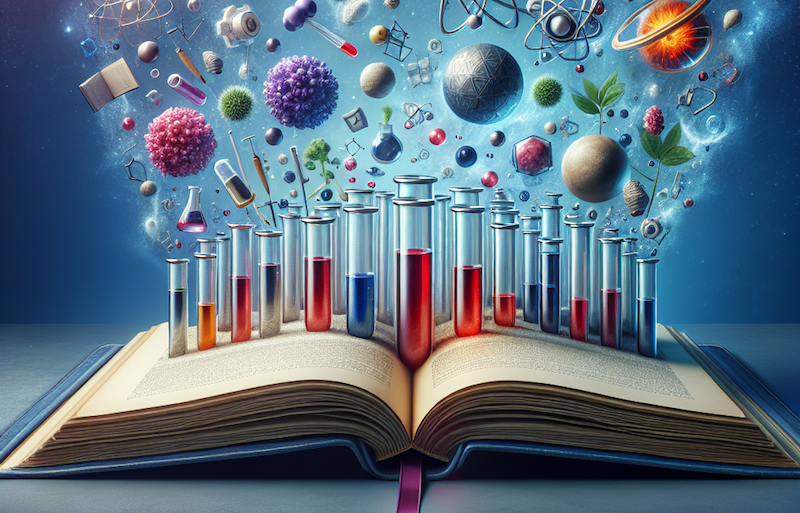Have you ever wondered if you can genuinely separate fact from fiction in science? True or False Science Facts is your chance to discover while embarking on a fun and educational adventure!
Science shapes our understanding of everything from the stars twinkling in the night sky to the microscopic cells that make up our bodies. Whether you’re fascinated by the vastness of space, intrigued by the mysteries of the human genome, or curious about the physics behind everyday phenomena, this quiz covers it all. We’ve crafted an exciting collection of statements spanning diverse themes such as Astronomy, Biology, Chemistry, Physics, and beyond.
Expect to explore the wonders of the natural world, delve into technological marvels, and even debunk some common misconceptions. Do you know how electricity works? Can you spot the myths about human health and nutrition? How well do you understand the impact of climate change? Each statement will challenge you to discern the truth, providing fascinating insights and nuggets of knowledge along the way.
This is more than just a test—it’s a journey through the intricate tapestry of science. Whether you’re a seasoned science enthusiast or a curious novice, you will discover something new.
The Importance of Understanding Science
Science is all around us, from when we wake up to when we go to bed. Understanding science isn’t just for scientists in labs—it’s essential for everyone. It helps us make informed decisions, solve everyday problems, and appreciate the world’s complexities. Whether deciding what foods are genuinely nutritious or understanding the latest news about climate change, a solid grasp of scientific principles enhances our lives.
This method isn’t just about testing knowledge; it’s about sparking curiosity, promoting critical thinking, and debunking myths that often cloud our understanding.
Engaging the Mind
The true or false format is a dynamic way to present scientific information. Each statement invites you to question what you know and consider why something might be true or false. It’s an excellent exercise in critical thinking, pushing you to apply logic and reason to each fact. For example, consider the statement: “Humans only use 10% of their brains.” It sounds intriguing, but it’s false. In reality, we use virtually every part of our brain, and most of the brain is active almost always.
Enhancing Recall and Retention
Studies show that active learning, such as quizzes and interactive activities, enhances recall and retention better than passive reading or listening. By challenging yourself with true-or-false questions, you’re more likely to remember the correct information and understand why it’s accurate, making learning stick.
Unveiling Misconceptions
True or false quizzes are also a great way to unveil and correct common misconceptions. For instance, many believe that cracking your knuckles causes arthritis. This is false; studies have shown no significant link between knuckle cracking and arthritis. By debunking such myths, you learn the truth and refine your ability to evaluate and question information.
Building a Foundation
Understanding science through true or false facts builds a foundation for lifelong learning. It equips you with the tools to navigate a world of complex scientific and technological issues. You’ll be better prepared to understand new scientific developments, engage in informed debates, and make sound decisions in your personal and professional life.
True or False Science Facts isn’t just a learning tool—it’s a bridge to scientific literacy, offering a playful yet profound way to understand the world. So, keep asking questions, challenging assumptions, and discovering the wonders of science!
Putting Your Knowledge to the Test: True or False Quiz on Science Facts
Ready to challenge your scientific smarts? Dive into this true or false quiz and see if you can distinguish science facts from fiction. Each statement below addresses a common belief. Some may seem obvious, while others require a bit of thought. Remember, it’s not just about getting the correct answer – it’s about understanding why it’s right or wrong.
Astronomy and Space
- True or False: Jupiter has a solid surface.
- False: Jupiter is a gas giant with no solid surface.
- True or False: The Milky Way galaxy is home to our Solar System.
- True
- True or False: The Moon is moving closer to Earth each year.
- False: The Moon is moving away from Earth.
- True or False: Black holes suck in everything around them, including light.
- True
- True or False: A year on Venus is longer than a day on Venus.
- True: Venus has a slow rotation compared to its orbit.
- True or False: Mars is known as the “Red Planet” due to its iron oxide-rich surface.
- True
- True or False: A comet’s tail always points away from the Sun.
- True
- True or False: The Sun is classified as a yellow dwarf star.
- True
- True or False: Neptune is the closest planet to the Sun.
- False: Mercury is the closest planet to the Sun.
- True or False: The Andromeda Galaxy is expected to collide with the Milky Way in about 4.5 billion years.
- True
Biology
- True or False: Humans have more bacterial cells in their bodies than human cells.
- True
- True or False: Plants produce oxygen during photosynthesis.
- True
- True or False: Blood is blue inside your body and turns red when exposed to oxygen.
- False: Blood is always red; veins appear blue due to light scattering.
- True or False: All species of octopuses have three hearts.
- True
- True or False: DNA stands for Deoxyribonucleic Acid.
- True
- True or False: The largest organ in the human body is the liver.
- False: The largest organ is the skin.
- True or False: Elephants are the only animals that cannot jump.
- True
- True or False: Humans share approximately 98% of their DNA with chimpanzees.
- True
- True or False: Penguins can fly underwater.
- True: Penguins swim using their wings.
- True or False: A koala’s fingerprints are so similar to a human’s that they can confuse crime scene investigators.
- True
Chemistry
- True or False: Water boils at 100°C (212°F) at standard atmospheric pressure.
- True
- True or False: Helium is the heaviest noble gas.
- False: Helium is the lightest noble gas.
- True or False: Gold is the most conductive metal.
- False: Silver is the most conductive metal.
- True or False: Table salt is composed of sodium and chlorine.
- True: The chemical formula for table salt is NaCl.
- True or False: Carbon dioxide is the gas that plants take in for photosynthesis.
- True
- True or False: Diamonds are made of compressed coal.
- False: Diamonds are formed from carbon under high pressure and temperature, not coal.
- True or False: The pH scale ranges from 0 to 14.
- True
- True or False: Rust is a result of the oxidation of iron.
- True
- True or False: Mercury is the only metal that is liquid at room temperature.
- True
- True or False: A molecule of water is made up of two hydrogen atoms and one oxygen atom.
- True: The chemical formula for water is H₂O.
Physics
- True or False: Light travels faster than sound.
- True
- True or False: The law of gravity was proposed by Albert Einstein.
- False: It was proposed by Isaac Newton.
- True or False: Energy can neither be created nor destroyed.
- True: This is the law of conservation of energy.
- True or False: Sound travels faster in air than in water.
- False: Sound travels faster in water than in air.
- True or False: Electrons are negatively charged particles.
- True
- True or False: An object in motion will stay in motion unless acted upon by an external force.
- True: This is Newton’s first law of motion.
- True or False: The speed of light in a vacuum is approximately 300,000 kilometers per second (186,000 miles per second).
- True
- True or False: Absolute zero is the lowest possible temperature where no heat energy remains in a substance.
- True
- True or False: The buoyant force on an object is equal to the weight of the fluid it displaces.
- True: This is Archimedes’ principle.
- True or False: Lasers work by focusing sound waves.
- False: Lasers work by amplifying light waves.
Everyday Science
- True or False: Microwave ovens cook food from the inside out.
- False: Microwaves cook food by agitating water molecules throughout the food, but the surface heats up first.
- True or False: Shaving hair makes it grow back thicker.
- False: Shaving does not affect hair growth.
- True or False: Lightning never strikes the same place twice.
- False: Lightning can strike the same place multiple times.
- True or False: Adding salt to water lowers its boiling point.
- False: Adding salt to water raises its boiling point.
- True or False: Eating carrots improves night vision.
- False: While carrots are good for eye health due to vitamin A, they don’t improve night vision beyond normal.
- True or False: Hot water freezes faster than cold water under certain conditions.
- True: This is known as the Mpemba effect.
- True or False: A penny dropped from a skyscraper can kill a person.
- False: A penny does not have enough mass to cause fatal injury at terminal velocity.
- True or False: Humans lose most of their body heat through their heads.
- False: Heat loss through the head is proportional to its surface area, like the rest of the body.
- True or False: You can’t start a fire with ice.
- False: Under the right conditions, ice can be used to focus sunlight and start a fire.
- True or False: Bats are blind.
- False: Bats can see, though they use echolocation to navigate in the dark.
These questions cover a broad range of scientific topics and are designed to challenge and educate while providing a fun learning experience.
Conclusion
By immersing yourself in these intriguing and often surprising questions, you’ve embarked on a transformative journey that has expanded your scientific understanding and honed your critical thinking skills. Whether you’ve debunked myths or confirmed facts, each step you’ve taken has brought you closer to becoming a more enlightened and inquisitive thinker.
Science thrives on curiosity and the quest for knowledge. By questioning what you know and verifying facts, you emulate the very essence of the scientific method. Each true or false question you’ve tackled is more than just a test; it’s a mini-exploration of the universe’s mysteries, from the tiniest atoms to the vast expanse of space. This learning method encourages you to think critically, analyze information, and approach problems with a scientific mindset.
Understanding science isn’t about memorizing facts—it’s about grasping concepts and seeing how they apply to the real world. Whether it’s the physics of a falling penny or the biology of your own body, this foundation of knowledge empowers you to make informed decisions in everyday life. The ability to discern scientific facts from fiction is crucial today, where misinformation is prevalent.
Learning continues further. The curiosity you’ve fed today is a seed for lifelong learning. Science is ever-evolving, and there’s always something new to discover. Keep questioning, keep exploring, and keep debunking the myths!
Remember, above all, that science is a thrilling adventure! It’s a journey brimming with wonder and discovery. From the strange but true quirks of nature to the incredible advancements in technology, the world of science is a treasure trove of amazement. Keep engaging with it, share your newfound facts with friends, and relish the exhilaration of learning something new every day.

